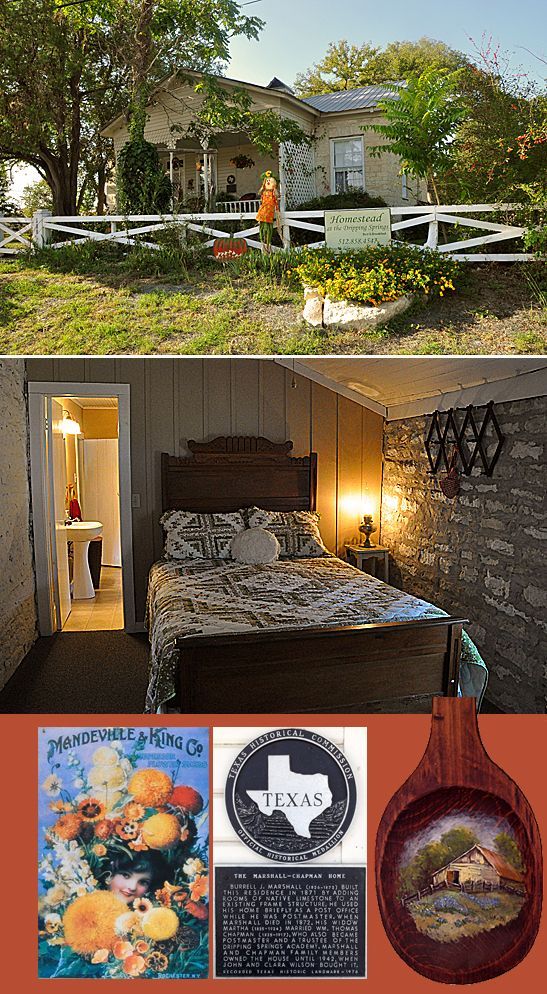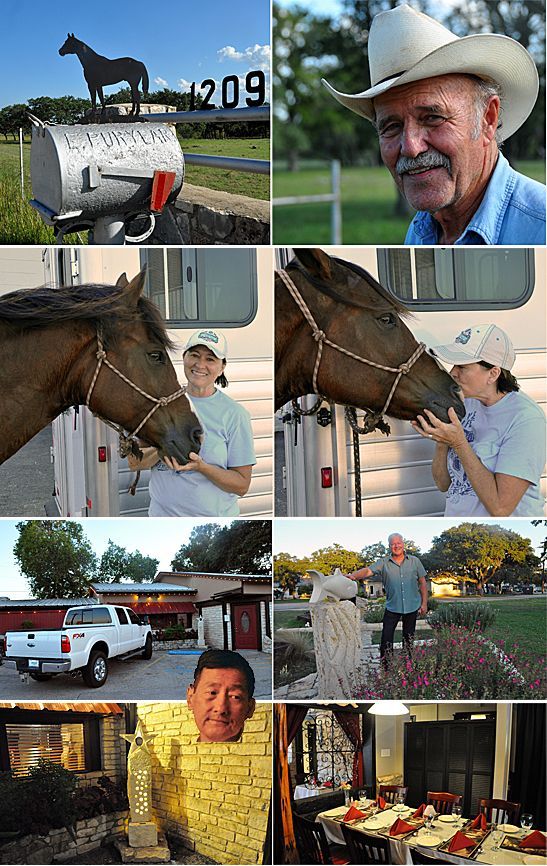Article
Dripping Springs, TX: Maybe the Hill Country Did Start Here
Author(s):
The name Dripping Springs doesn't conjure up Texan grandeur. But it is what it is: the place where in 1854 Nannie Moss noticed that priceless commodity in a dry and dusty land-water-dripping from soaking ferns on their property and had her Eureka! Moment.
The name Dripping Springs doesn’t conjure up Texan grandeur. But it is what it is: the place where in 1854 Nannie Moss noticed that priceless commodity in a dry and dusty land—water—dripping from soaking ferns on their property and had her Eureka! Moment.
The 3 families who came and established this little community were the Moss, the Wallace, and the Pound families. We are staying in the original Moss home, now the Homestead B & B and visiting the Pound House tomorrow, the home of Joseph M. Pound, MD, the first physician in this Texas county. The stage coach from Austin to Fredericksburg stopped at the Homestead and when a B.J. Marshall became the owner he also became the postmaster and his home the post office. Our B & B is a mere 29 miles west of Austin airport.

Charles and Sherry Haydon
We are sitting opposite our hosts, Charles and Sherry Haydon, trying to make sense of all this community history. Charlie Haydon is the grandson of John W. and Clara Wilson who leased the house in the 1930s and bought it in 1942. Clara was born in a log cabin on the Blanco River and clearly made an impression on her young grandson. “She was 5 foot 8 inches,” says Charlie. “I called her ‘Big Mama.’ She died aged 95 in 1985.”
Charlie has a brother who is a family physician in Brenham, TX. He, himself, is a retired history teacher and school counselor—and now that he owns the homestead with Shelly he has become a “primitive carpenter.” Did he teach locally? No, the town’s population is 1,800. “I’m related to half the people in town!”

The Homestead B & B
We ask this former history teacher if he feels the future is a little scary. Is America on the right path?
“I’m an optimist,” he says. “I have faith in my people—in the resilience of pioneer children. The human spirit. But we have to adapt. It used to be that people in Dripping Springs have been born here and died here but now we’re a bedroom community for Austin.”
Does that mean a risk of lost identity?
“I don’t think so,” he replies, “But if you don’t know where you’ve been, you don’t know where you’re going!”
Well, today for once, we know where we’re going—across the street to have lunch with Pam Owens, the director of the Dripping Springs Visitors Bureau, but first we have to meet Morgan. He is apparently a regular at the Mazama Coffee Company but a picky eater. We meet Pam and Morgan there although Pam had to be coerced to pose with him. We have a medical background so we know why Morgan is not eating well. We explain it to Pam. She grins and says, “I was pretty sure you’d understand. I knew you’d get it!”

Morgan apparently has written a warning for visitors to Dripping Springs. His note reads, “Don’t make eye contact with Morgan.” Given the, er, comeback zombies are making in current culture that’s probably sound advice.
We go off with Pam our guide to learn more about this small place. “We are new to tourism,” she admits. “We were always a dry county but 9 years ago we went wet — and what a change! It revitalized the town. We’ve gone from a community of mostly goat ranching to a trading area of about 35,000—and with 30 wedding venues, we are the wedding capital of Texas!” We are both a bit deaf and weren’t sure if we’d heard right. “Did you say Texas or the world?” we ask. “Actually, I said Texas but Texas is the world,” she says with a grin. We are reminded that Texans don’t take themselves too seriously much of the time.

Onion Creek and its farms.
The town has diversified services: Onion Creek Farm offers chickens and fresh eggs and Pure Luck Texas is an award-winning goat farm. Olive Oil businesses are showing up in this part of Texas. Olive trees love the heat and the limestone soil; they don’t like standing water, rain, or hard freezes or even repeated fluctuations with cold and warmth which is typical of the Texas hill Country in the spring. The olive oil industry started in Marble Falls, TX when John Henry planted an olive orchard in 1993 “and it immediately died. Twice.” Henry moved southwest of San Antonio, 45 miles north of Mexico, and became very successful.
The most successful olive oil producer in Dripping Springs is John Gambini, who wanted to be a Texas wine pioneer yet when he looked into it in 2003, “found 162 wineries had beaten him to it.” His Texas Hill Country Olive Oil Company started with a planting of 2,000 trees in 2009 on 16 acres and because he’d started with trees that were 4 years old he had harvests in ’12 and ’13.

Camp Lucy in the Wedding Capital of Texas
We ask to see one of the fanciest wedding venues so Pam takes us to Camp Lucy named after Lucy Hanks, the wife of rancher Roger Hanks. Their son Whit had a vision that men in tuxedos and cowboy boots should marry loved ones in unique splendor. How unique? In a 1880s Catholic chapel transplanted from Vietnam with the original bell brides can ring when the marriage is finalized. It has an Ohio Amish barn for the reception—with the canning lids that were used as markers now permanently located on the beams and walls. Another unique feature? The barn served as part of the Underground Railroad for runaway slaves seeking freedom in the north. One of the stones now incorporated in the fireplace still carries the emblem of the cross recognizable by slaves as a sign of safe haven.

Rancher Robert Puryear, rodeo rider Jean Hall. Restaurateur Carl Shroyer and (insert) chef Chae Donahue.
The strength of a community lies, of course, in its people. We talk to local rancher Robert Puryear who is mending one of his fences. He is also a skilled welder and designed his own mail box and the art along his fences. We put him the question “Is Texas special?” He straightens up and drawls, “This is the only place I’ve lived but what I’ve heard about other places I’d just as soon stay here.” We check out the vast agricultural complex the town is developing and meet Jean Hall and her trained quarter-horse. Jean is an experienced barrel racer at rodeos and has probably taken part in 2,000 over the years. We ask, “How do men handle it if she beats them?” “It’s when not if, “ she says, “There’s not a huge number of men in barrel racing but they do enter in the jackpot races which is when I beat ‘em.”
Downtown stands Dripping Springs’ only example of fine dining, the Creek Road Café. Carl Shroyer, the general manager co-owns the restaurant with the chef, Chae Donahue. It opened in 2008 to receive the New Business of the Year Award from the Suits and Boots Celebration at the Chamber of Commerce. People working in Austin who chose to live in a quieter part of the state moved in with, we would guess, more sophisticated palates. The owners are good friends and Carl has a framed notice on the wall showing Chae received a successful double lung transplant in 2012.
Recommended also for a simpler meal is Rolling in Thyme & Dough, a great sandwich shop started, presumably after she got over the culture shock, by a woman from Belgium. After being established for 3 years, it won the 2008 Business of the Year Award from the same Suits and Boots. We find from clicking here that our helpful guide, Pam Owens, previously seen sitting with Morgan the skeleton, was the Citizen of the Year in 2008.

The Barber Shop bar has a tin wall donated by a friend when the barn was destroyed by a tornado, and a pecky cypress counter given by another friend. It has the original compressor left by Texaco on one wall, a beer can collection on another, Western paintings, a band, Hot Tub Cousins, playing on the patio, and an owner raising his beer glass to salute Physician’s Money Digest but not offering his guest a beer!
So what’s special about Dripping Springs? Pam Owens has the answers:
- We have the original German background that gives us pride in our homes, our businesses and even our persona. We are cautious in collecting rainwater and conservative in the use of electricity. We are part of the natural life—we live it!
- We are still a small town with only 5 traffic lights and no parking fees.
- We have a sense of community with services for that community, not travelers, so visitors find prices, for example, in restaurants are very reasonable.
Is there a down side to that? Just that everyone who moves here wants to be the last one to pull up the rug!
So what’s left to do in this little town? Certainly a walk downtown along the main street. The Visitor Center even has a walking map to show what you are passing. You end up at what was a Texaco Station in the 1920s and became the Barber Shop in the 1980s. It has retained the name but is now a bar. Says Dave Niemeyer, co-owner, “We keep a record and since we opened in February of 2011, a total of 143 people have come in asking for a haircut!”
Says Dave, “There are 5 local breweries within 10 miles and we have 18 beers on tap and we brew our own. We have educated the people that beer is more than a light vodka!”
So we have finished exploring Dripping Springs and tomorrow we head for the Pound House, the 1847 home of the area’s first doctor.
Photography by the authors
The Andersons, who live in San Diego, are the resident travel & cruise columnists for Physician's Money Digest. Nancy is a former nursing educator, Eric a retired MD. The one-time president of the NH Academy of Family Physicians. Eric is the only physician in the Society of American Travel Writers. He has also written five books, the last called The Man Who Cried Orange: Stories from a Doctor's Life.




